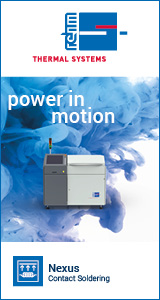|

|
|
| Ask the Experts | |||||||
|
|||||||
|
May 15, 2018 - Updated July 6, 2010 - Originally Posted Options for Reducing DrossWhat are all the possible options we should explore to cut down on the amount of solder dross we see in our wave soldering system? V. M. |
|||||||
| Expert Panel Responses | |||||||
|
Hundreds of customers worldwide and many of the worlds large contract manufactures have found the best way to handle dross on your wave is to mechanically recover the pure solder which will be between 80% and 90% of the dross by weight. Using and EVS Solder Recovery System is fast and simple and will recover 50% to 70% of this solder from the dross by weight in only a 6 to 10 minute cycle with no extra work than what you are doing now when you dedross. The ancillary benefits of using a solder recovery system are many and documented. You will get a much cleaner wave which will reduce shorts and bridging on your PCB leading to significant reductions in rework. As you have a cleaner wave you will get less maintenance on your pumps and nozzles and as you can significantly reduce the time it takes to dedross productivity will improve substantially. You are putting back in to your wave exactly the same solder that is already there with no additives in to your process. For full details have a look on the EVS website http://www.solderrecovery.com/
International Director EVS International Simon G. Norman is the international director for EVS International, the Leader in Solder Recovery.
Options to reduce dross in wave soldering systems are:
Managing Director, Asia Pacific ECD EH Lim has been in the PCB Assy industry since 1985, starting at Thomson/Singapore for 5 years before moving to Electrovert Asia Pacifc. Lim was Sales Director for Vitronics Soltec prior to joining ECD in 2007 as Managing Director for Asia Pacific.
My recommendation is to use the MS2 product from PK Metal. Contact Larry Kay at larrykay@pkaymetal.com We have done extensive testing and it works great.
President/Senior Technical Consultant Foresite Mr. Munson, President and Founder of Foresite, has extensive electronics industry experience applying Ion Chromatography analytical techniques to a wide spectrum of manufacturing applications.
I would suggest you contact your solder supplier, most supply a dross reducing fluid that is specific for your formulation of solder. Most of these fluids float on the top of your solder bath reducing the amount of oxygen that contacts the solder.
Regional Sales Manager OK International Inc. Ed Zamborsky is a Regional Sales & Technical Support Manager for Thermaltronics, located in New York. His position requires frequent customer visits throughout North America and the Caribbean and his position encompasses not only sales but the role of trainer and master applications engineer for all of Thermaltronics products. His expertise includes such specialties as hand soldering, convection and conduction reflow techniques, array rework, fluid dispensing equipment, and fume extraction. Ed has authored many articles and has presented many papers on topics such as; Low Volume SMT Assembly, Solder Fume Extraction, SMT Rework, BGA Rework, Lead-Free Hand Soldering, High Thermal Demand Hand Soldering, Lead Free Visual Inspection and Lead Free Array Rework.
Reader Comment
Insure all the bits & pieces of your wave formers are in place & functional. Some manufacturers provided dross & choke plates to build up a secondary solder level to reduce the vertical fall which in turn reduces dross. I've seen many waves where these parts were removed years ago as those who knew of their function are retired or dead & buried. (I'm the exception)
Another great point touched on by EH Lim an old EV colleague is to raise the pot and lower the wave. Many assemblers have a universal pot setting and that has to account for the longest leads or protrusions meaning 95% of assemblies could probably run with higher pots and lower wave settings. My 2 cents.
Ray Chartrand, Chartrain Consulting, USA
Reader Comment
Mechanical dross "squeezing" does not recover metal, it just separates the oxide from the metal that has not really become dross yet. Liquids come in two categories, some like oils just inhibit oxygen from getting to the solder, they slow down dross formation some but they have other issues. The newer technology, such as MS2 from P.Kay Metal actually breaks the organometallic bond, liberating the oxygen and allowing pure, clean solder to return to the solder pot ready for use.
It works very well and it greatly reduces the consumption on an expensive commodity. solder. This process is now being used on many hundreds of lines world wide and its use is accelerating.
Dan Feinberg, Fein-Line Associates, Inc.
|
|||||||
| Submit A Comment | |||||||
|
Comments are reviewed prior to posting. You must include your full name to have your comments posted. We will not post your email address. |
|
Free Newsletter Subscription
Circuitnet is built for professionals who bear the responsibility of looking ahead, imagining the future, and preparing for it. Insert Your Email Address |
|

|






